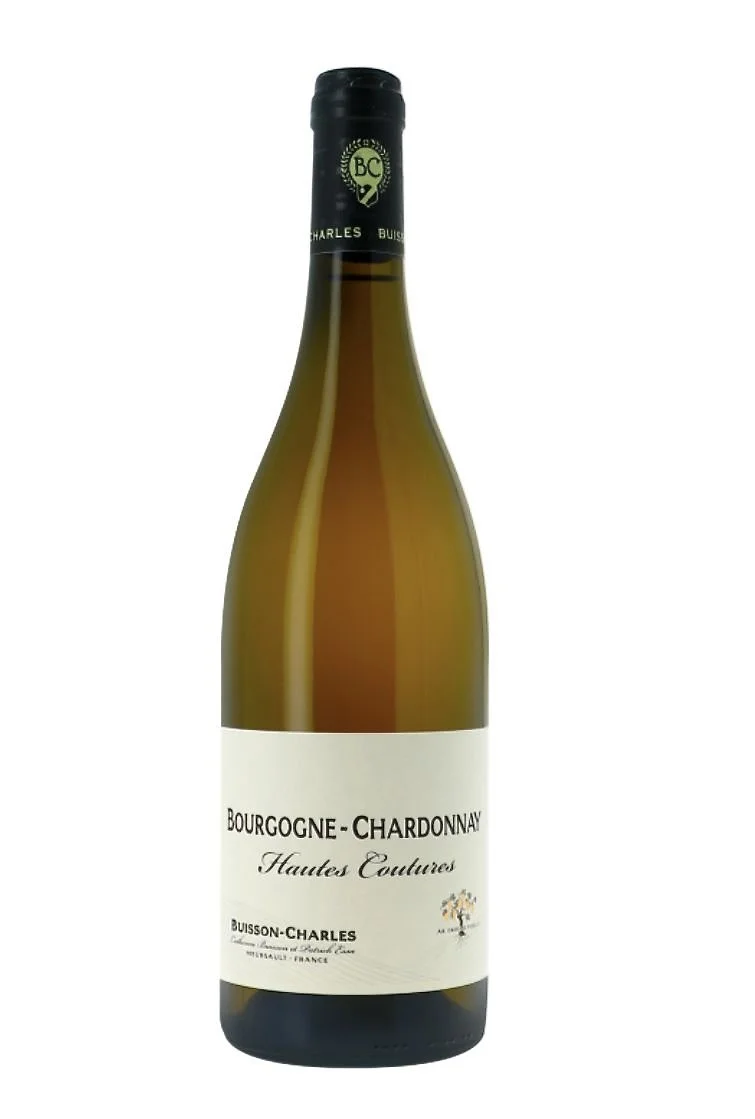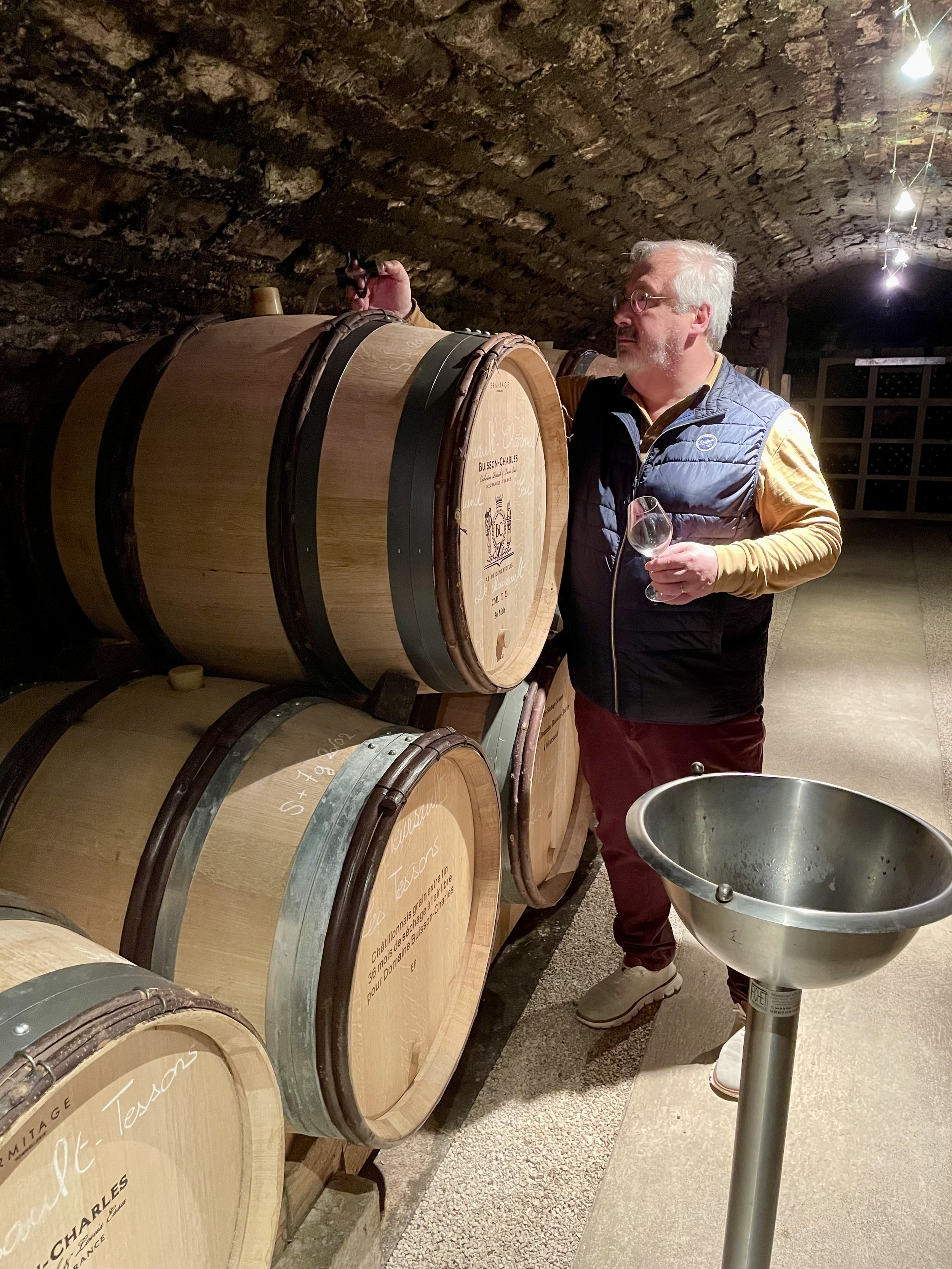
Bourgogne Aligoté
Sous le Chemin "Hors Classe"
This Aligoté is grown in Meursault's "Sous le Chemin," made remarkable wine in 2019, prompting the domain to isolate the vineyard's oldest section from the 1950s. These vines naturally develop a golden hue at ripeness, yielding highly concentrated grapes. From this 26 ares plot, they craft around 1500 bottles, embodying Meursault's terroir. Named "Hors Classe," inspired by 19th-century Burgundian classifications, it adheres to strict guidelines: manual harvest, in-field sorting, whole-cluster pressing, low yields, natural alcohol, wood fermentation and ageing, and bottling without fining or filtration.

APPELLATION
AOC Bourgogne Aligoté
PRODUCTION
Around 1500 bottles
GRAPE VARIETY
100% Aligoté
ÂGE OF THE VINE
A blend from different ages
SOIL
Limestone & clay soil
SIZE
Contact us
VITICULTURE
Sustainable
VINEYARD’S ORIENTATION
South / South-East
Buisson Charles’s others cuvées
-
![Bourgogne Chardonnay Côte d'Or "Hautes Coutures"]()
Bourgogne Chardonnay Côte d'Or "Hautes Coutures"
This wine is made from grapes sourced exclusively from Meursault, from three parcels nestled in limestone-rich soils, totalling 52 ares in Hauts de Coutures and Magnys plots. With vines aged 10 to 50 years, the domain meticulously pruned the vines with Guyot and cordon de Royat techniques. High-density planting, ranging from 14,500 to 17,000 plants per hectare, ensures optimal fruit concentration. Yielding below 50 hl/ha, our organic practices extend to manual harvesting, pneumatic pressing, and vinification and ageing in Tronçais forest oak barrels, 10% new, with bottling occurring unfined and unfiltered.
-
![Bourgogne Aligoté "Sous le Chemin"]()
Bourgogne Aligoté "Sous le Chemin"
This Aligoté is cultivated on a 46-ares plot in Meursault's "Sous le Chemin." Grown in rich clay-limestone soil with vines over 45 years old, it exhibits remarkable concentration and unexpected power for its varietal. Reflecting Meursault's terroir, it undergoes 12 months in barrels and 3 to 5 months in stainless steel tanks for freshness and refinement. Bottled after light fining, it promises purity and finesse, evolving gracefully for over 15 years while delivering intense fruitiness in its youth.
-
![Meursault Vieilles Vignes]()
Meursault Vieilles Vignes
The estate's Meursault "village" is a blend of six parcels, sourced from old vines over 45 years old. These parcels, spanning over two hectares surrounding the village, offer diverse terroirs. Slope-grown vines like Vireuils and Meix Chavaux provide freshness, while those near the premiers crus, such as Marcausses, Vignes Blanches, and Pellans, impart body. The Millerands parcel on gravel adds finesse. Always highly concentrated, the domain's Meursault Vieilles Vignes requires bottle ageing for full expression. Vinified and aged exclusively in 228-liter barrels, around 20% new.
-
![Meursault Les Tessons]()
Meursault Les Tessons
The lieu-dit «Tessons » is arguably the finest lieu-dit classified as AOC village in Meursault. Positioned on a perfectly drained, gravelly, east facing slope, its slightly reddish clay-limestone soil, due to the presence of ferruginous oolite, lends wines remarkable power alongside immediate aromatic allure. Primed for long ageing, it also offers enjoyment in its youth. With 34 ares of this terroir, Domain BuissonCharles often regards it as on par with the premier crus they produce, particularly in early years, where its extraordinary tactile texture shines. It bears a clear resemblance to the neighbouring Goutte d'Or.
-
![Meursault Vigne de 1945]()
Meursault Vigne de 1945
The vineyard, planted in March 1945, just before the end of World War II, lies beneath Meursault Charmes in the lieu-dit "Les Pellans." Its slender Chardonnay vines yield sparingly, typically around 40 hl/ha from 11,000 plants. The domain has chosen to isolate it and vinify it as was done in the 1940s and 1950s. Gentle pressing, no settling, minimal intervention except for a touch of sulfur during vinification, aged in barrels for over two years for 18 months. Bottled unfined, unfiltered, with minimal sulfite and a gas level of 950mg/l. They skipped production in 2016 but made 7 barrels in 2017, 2018, 2019, and 2020 following the same protocol.
-
![Pouilly-Fuissé Terroir de Vergisson]()
Pouilly-Fuissé Terroir de Vergisson
The wine comes from a vineyard where are planted 8,000 vines per hectare, comprising vines over 40 years old trained using a single-wire system. With double spring pruning and full soil ploughing, yields range from 40 to 55 hl per hectare. Grapes are hand-harvested and sorted before pneumatic pressing. Barrel ageing for 17 months precedes bottling without fining or filtration, resulting in approximately 900 bottles per vintage. Best enjoyed between 2 and 12 years, Vergisson's vineyards cover nearly 200 hectares, yielding refined wines characterized by pronounced internal energy, setting them apart within the appellation.
-
![Bourgogne Pinot Noir Côte d'Or "Hautes Coutures"]()
Bourgogne Pinot Noir Côte d'Or "Hautes Coutures"
This Bourgogne Rouge is crafted from two distinct parcels of Pinot Noir vines, each over 50 years old. Situated in Puligny-Montrachet's Champans (32 ares) and Meursault's Hautes Coutures or Grandes Coutures (45 ares), they undergo barrel ageing following premier cru quality standards, with 30% whole bunches. This approach yields an approachable, flavorful wine that can be enjoyed young, yet its rich texture and concentrated tannins ensure it can mature gracefully for over a decade. Since the 2016 vintage, the labels state Côte d'Or name on its label.
-
![Pommard en Mareau]()
Pommard en Mareau
Nestled within the "en Chiveau" sub-area, part of Mareau, lies a discreet plot yielding Pommard village, crafting fewer than 1500 bottles annually. This vineyard, established in 1985, thrives in Pommard's clay-limestone terrain mingled with ferruginous oolite, benefitting from a cooler East-Northeast exposure in the Combe de Pommard. Unlike its softer counterparts, this wine typically exudes power and minerality, aging gracefully for over two decades. Vinified with a modest proportion of whole clusters, it matures for 17 months in barrels, with 30% new oak.
-
![Meursault Goutte d'Or]()
Meursault Goutte d'Or
The small Goutte d'Or vineyard spans just over five hectares, and while its name is famous for its pleasing sound, it is rarely encountered on tables worldwide because fewer than 60,000 bottles are produced each year for the entire cru. Domaine Buisson-Charles exploits 26 ares located right in the middle of the climate; the rows cut across the entire cru from top to bottom, and, facing due east, they benefit from ideal sunlight exposure, which protects them from excessive heat
-
![Meursault Bouches-Chères]()
Meursault Bouches-Chères
Nestled adjacent to Goutte d'Or on an east-facing slope stretching towards Poruzots and Genevrières, Bouchères is a hidden gem among Meursault's premier crus. Its steep, gravelly, clay-limestone soil produces wines with an ethereal quality reminiscent of upper Genevrières or lower Chevalier-Montrachet. Despite their delicate nature, Bouchères wines boast surprising ageing potential, with some bottles from the 1950s and 1960s still showing pristine condition. The domain labels its wines as Bouches-Chères, a term echoing the 19th-century nomenclature.
-
![Meursault Charmes]()
Meursault Charmes
Charmes is Meursault's largest premier cru, spanning nearly 35 hectares. It embodies the essence of the village's dry and luscious wines. Divided into three subzones (Dessus, Milieu, Dessous), Charmes lacks unity. Wines from Dessous are immediately accessible and supple, while those from Milieu are more intense and concentrated. In Dessus, they are vivid, airy, and tense. Situated on a gently sloping, sunny, stony terrain, vines penetrate deep into the clay-limestone soil, resulting in intensely aromatic and concentrated wines. Domaine BuissonCharles owns a small 18-ares parcel in Charmes Du Dessus, adjacent to Genevrières and just below Grande Perrières, producing approximately 1000 bottles annually.
-
![Meursault Cras]()
Meursault Cras
A 20-ares vineyard, planted in 1955, yields approximately 1200 bottles annually. The sunny site, situated midway up the slope, ripens quickly, demanding precise harvest timing to avoid overripeness. Grapes undergo meticulous sorting, discarding any underripe, overripe, green, or botrytized berries for consistency and purity of fruit. Following pneumatic pressing, the wines age for 17 months in Tronçais oak barrels, with 25 to 30% new wood carefully chosen for minimal wood influence, employing medium toasting and hot water rinsing to remove any residual toasting before filling with must.
-
![Puligny-Montrachet 1er Cru le Cailleret]()
Puligny-Montrachet 1er Cru le Cailleret
This unique cru blends the finesse of Pucelles from Puligny-Montrachet with the restrained power of true Montrachet, enchanting with floral notes and a simultaneously sleek yet densely textured palate. Delighted to vinify it since 2013, the domain produces one to two barrels annually of this elite cru from just over ten ares. Yields range from 30 to 45 hectoliters per hectare, with manual harvesting and grape sorting at the vineyard table. Subsequent pneumatic pressing and static settling precede barrel aging, with 30% new wood, and bottling after a light fining process.
-
![Puligny-Montrachet 1er Cru les Combettes]()
Puligny-Montrachet 1er Cru les Combettes
The Combettes vineyard once labelled Meursault Combettes due to its stylistic similarity to Meursault's premier crus, now resides within Puligny-Montrachet. Mainly owned by Prieur de Meursault with nearly 2 hectares, and domain Ampeau of Meursault with 2/3 of a hectare, alongside smaller properties like Carillon and Sauzet. Combettes' soil, akin to Meursault's Charmes Dessus, boasts clay-limestone composition, rapid drainage, and eastern exposure. Producing intensely flavoured wines with a velvety texture, it ages gracefully, retaining its hawthorn bouquet and nuances of hazelnuts over decades.
-
![Chassagne-Montrachet 1er Cru La Romanée]()
Chassagne-Montrachet 1er Cru La Romanée
Located north of Chassagne, La Romanée Premier Cru is among the finest climats in the commune, close to Grands Ruchottes and Caillerets. Its prestigious name adds value to its allure. Perched atop a steep slope, it overlooks small vineyards, facing east. With limestone-rich brown soil, quick-draining, and precocious, it yields wines of energetic nature and undeniable finesse. Covering just over 4 hectares, shared among five owners, Romanée's rarity and quality position it among the top premier crus of the region.
-
![Chassagne-Montrachet 1er Cru en Remilly]()
Chassagne-Montrachet 1er Cru en Remilly
Domaine Buisson-Charles released about 600 bottles of Chassagne-Montrachet Premier Cru en Remilly for the first time in the 2010 vintage. This small production is significant in several ways. Remilly is a tiny climat, occupying less than 1 hectare, nestled between the renowned "Remilly" of Saint Aubin and Puligny-Montrachet's Chevalier-Montrachet grand cru. Its high-altitude position facing south lends the wine a unique texture and remarkable freshness. It produces a stony, subtly saline wine best harvested early to maintain its grace and energy.
-
![Volnay 1er Cru En Santenots]()
Volnay 1er Cru En Santenots
Legally entitled to the Volnay Premier Cru appellation despite its location in Meursault, the vineyard is located between the Caillerets and Chevrets of Volnay. The 27-are plot, planted in 1954, benefits from an elevated position overlooking the "Petures" sub-climate, resembling Volnay's Caillerets. Its east-facing slope ensures ample sun exposure, resulting in consistent ripening that mitigates vintage variation. Grapes are meticulously sorted and vinified, with up to 50% whole clusters depending on the vintage. After a pneumatic pressing, the wine ages for 15 to 18 months in Tronçais forest barrels sourced from the neighbouring Nivernais cooperage, Ermitage.
-
![Volnay 1er Cru Champans]()
Volnay 1er Cru Champans
Situated on a sheltered mid-slope facing east, the climate's marly-limestone soil, marked by ferruginous oolite, rests atop a mother-of-pearl slab. Resurging from the Middle Jurassic era, it extends into Caillerets and Santenots, distinct from Pommard due to its geological complexity. Despite its slope rising noticeably from the middle, it lacks subzones, as many parcels traverse the hill. The wine originates from the northern end, near the village and Chapelle du bas de Volnay, benefiting from a slight plateau that enhances solar absorption, enriching the grapes.
-
![Volnay 1er Cru Les Fremiets]()
Volnay 1er Cru Les Fremiets
The 7.91-hectare Frémiets climate yields some of Volnay's most delicate and subtle wines. Situated above the path to Fremiers and Jarollières of Pommard, its slope steepens, soil losing clay richness and lightening as it ascends. Sheltered but less sunny than below, it boasts denser stone concentrations amidst marly limestone. Numerous plots intersect this slope longitudinally, benefiting from its soil complexity. Wines from here are often more tense and lively, preserving exceptional elegance and character. The domain's 25 ares of vines originate from this sector.
-
![Chablis Grand Cru Vaudésir]()
Chablis Grand Cru Vaudésir
New appellations produced by the domaine include Chablis Grand Cru Vaudésir and Premier Cru Chablis, sourced from purchased musts and vinified and aged in Meursault. The barrels, aged 2 to 5 years from Ermitage, Rémond, and Damy cooperages, undergo a meticulous drying process of 24 to 36 months to avoid imparting woody flavors, preserving their natural tension and freshness. Vaudésir grapes come from the ideal Vaudésir amphitheatre, including the renowned Moutonne area, while Lys grapes, also entitled to the Vaillons appellation, originate from 40-year-old vines in the heart of the climate. After 17 months of ageing, they are bottled and available for sale starting in February.
-
![Corton-Charlemagne]()
Corton-Charlemagne
The latest addition to the estate's portfolio, the domain is expected to produce around 600 bottles from its 11 ares. Here's a glimpse into the character of this coveted grand cru cherished by enthusiasts: crafted by Buisson-Charles, it originates from the esteemed Grand Cru of Le Charlemagne, nestled in the prime mid-slope terroir of Aloxe Corton.
-
![Corton Blanc Grand Cru "Le Clos des Chaumes"]()
Corton Blanc Grand Cru "Le Clos des Chaumes"
Since 2011, the domain has expanded its offerings to include the opportunity to vinify and age the wonderful Clos des Chaumes, entitled to the Corton Blanc Grand Cru appellation. Situated just below the famed original Clos Charlemagne, it overlooks an ancient quarry and basks in a southern exposure, ensuring optimal ripeness. With vine rows oriented east to west on a gentle slope, the vines absorb the full essence of this lower hillside. These wines are characterized by their generosity and fullness, maintaining the natural richness of Chardonnay without sacrificing vibrancy. Production began with the 2018 vintage.
-
![Corton Clos du Roi]()
Corton Clos du Roi
With vines over 55 years old, Clos du Roi spans 10.74 hectares, forming an almost perfect rectangle facing east on a firm slope between 270.04 and 320.52 meters. Its Bathonian soil, rich in iron oxide and composed of crumbling lava, imparts a rugged, athletic nature to the wines, reminiscent of Volnay's Champans or Pommard's Rugiens, with more pronounced dark fruitiness and an even stronger sense of fullness at times. Production ranges from 300 to 900 bottles per vintage.
-
![Corton-Bressandes Grand Cru]()
Corton-Bressandes Grand Cru
Spanning 17.42 hectares, unofficially the largest cru in the Côte de Beaune, Corton offers accessibility with its widespread distribution. Facing due east above Maréchaudes, its terrain comprises ferruginous, rocky soil rich in potash, promoting rapid drainage to prevent water saturation in the fruit. With an average altitude of 260 meters, it boasts a potential for a refined, fragrant wine style. Cultivated organically, with yields capped at 35 hl per hectare, manual harvesting, pneumatic pressing, and 30% new oak barrel ageing contribute to a production of 600 to 900 bottles per vintage.
-
![Corton Perrières]()
Corton Perrières
Spanning nearly 10 hectares, the Corton-Perrières distinguishes itself through two distinct zones shaping its expression. This rocky climate, enveloping the Grancey cellar, features a lean, light brown, low-clay soil at its upper part, where plants tend to struggle, naturally yielding low quantities. Consequently, it ripens quite early, exhibiting assertive maturity when harvested at the right moment. With its supple texture, it stands as one of the delicately refined wines of the region, producing 300 to 600 bottles per vintage, boasting vines aged over 60 years.
-
![Chapelle-Chambertin Grand Cru]()
Chapelle-Chambertin Grand Cru
The Grand Cru Chapelle-Chambertin spans 5.48 hectares on a gently sloping terrain facing east, among the sunniest and earliest ripening areas in Gevrey. Its soil, composed of white limestone scree, ensures optimal drainage, with some rocky outcrops at higher elevations. However, lower sections tend to be more clayey, imparting a touch of severity to the wine, contrasting with its typically refined and terroir-driven character. Planted in 1962 and 1970, it yields 300 to 600 bottles annually, cultivated through organic and biodynamic practices, with full soil tillage and yields ranging from 30 to 45 hectoliters per hectare.
-
![Chambertin Grand Cru]()
Chambertin Grand Cru
From the 2020 vintage, they produce around 300 bottles of this Grand Cru. With Chapelle, it marks the domain's second wine from the Côte de Nuits. Cultivated organically, it lies just outside Gevrey-Chambertin, extending from Clos de Bèze, facing due east. Its lower and middle soils consist of Lower Bajocian limestone with entroques, while the slightly steeper, rockier upper section bears marly beds directly.

Domaine Buisson Charles
Meursault
Established in the middle of the 20th century, the domain is located in Meursault and has been managed since 2001 by Catherine and Patrick Buisson.
The Buisson-Charles domain is of modest size - 6.3 hectares, including 4 hectares of Meursault village and Meursault premiers crus in diverse climates.
It is complemented by its ownership of plots in Volnay and Pommard, as well as its négoce activity with Corton and Chambertin for red wines, and Chassagne-Montrachet, Puligny-Montrachet, Chablis Premier Cru and Grand Cru, Pouilly-Fuissé Premier Cru, and Corton-Charlemagne for white wines.
Even though Catherine and Patrick are managing the estate, they also have the privilege of seeing their son Louis return to the operation after obtaining his degree in winemaking engineering.
There is no doubt that he will be called upon to succeed his parents in the years to come. 2019 is the first vintage that he has entirely vinified.



